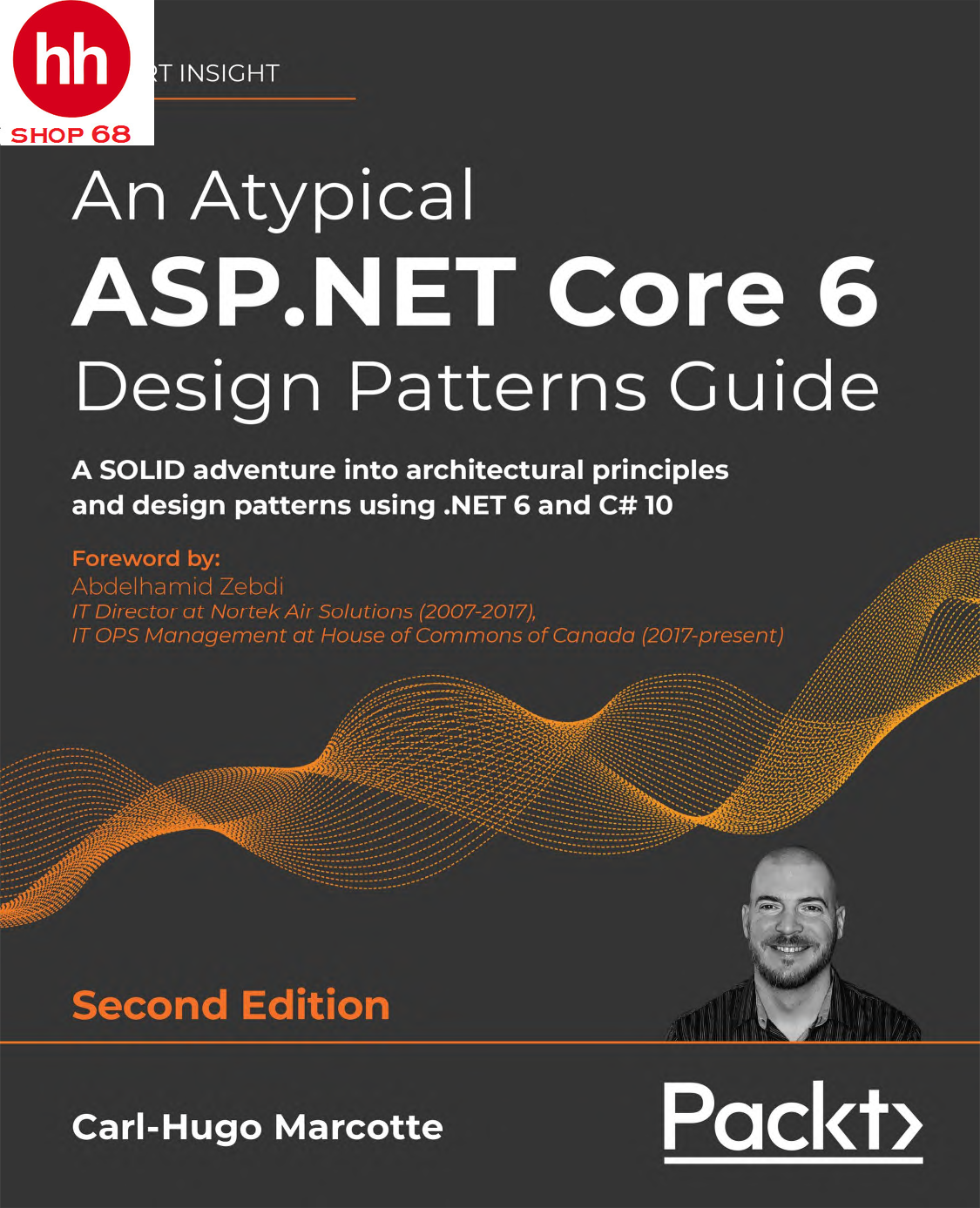Còn hàng
An Atypical ASP.NET Core 6 Design Patterns Guide: A SOLID adventure into architectural principles and design patterns using .NET 6 and C# 10, 2nd Edition
Tình trạng:
Còn hàng
Tác giả: Đang cập nhật...
Loại: Đang cập nhật...
Nội dung đang cập nhật...
[Xem chi tiết]
180.000₫
200.000₫
-
Mô tả
ĐẢM BẢO " KHÔNG LỖI , KHÔNG ĐEN HÌNH ,KHÔNG ƯNG HOÀN TRẢ TIỀN "
Bản in đen trắng - Bìa mầu, gáy keo nhiệt cực chắc chắn.
Giấy in ngoại nên viết vẽ và hightlight thoải mái.
Chất lượng rõ nét, chữ rõ ràng, giá rất tốt cho mọi người.
Mọi chi tiết xin liên hệ với Shop.
------------------------------------------------------------------------------------
An Atypical ASP.NET Core 6 Design Patterns Guide: A SOLID adventure into architectural principles and design patterns using .NET 6 and C# 10, 2nd Edition
Author : Carl-Hugo Marcotte , Abdelhamid Zebdi
Publisher : Packt Publishing; 2nd ed. edition (March 28, 2022)
Language : English
Pages : 678 pages
1) Book Description
The professional developer's essential guide to building robust, maintainable, and flexible web apps by leveraging C# 10 and .NET 6 features and component- and application-scale design patterns
Key Features
Apply the SOLID architectural principles and software design patterns effectively with a focus on dependency injection
Discover modern application architectures such as vertical slice, clean architecture, and event-driven microservices
Explore full-stack ASP.NET Core with an overview of Blazor
Book Description
An Atypical ASP.NET Core 6 Design Patterns Guide, Second Edition approaches programming like playing with LEGO®: snapping small pieces together to create something beautiful. Thoroughly updated for ASP.NET Core 6, with further coverage of microservices patterns, data contracts, and event-driven architecture, this book gives you the tools to build and glue reliable components together to improve your programmatic masterpieces.
The chapters are organized based on scale and topic, allowing you to start small and build on a strong base, the same way that you would develop a program. You will begin by exploring basic design patterns, SOLID architectural principles, dependency injection, and other ASP.NET Core 6 mechanisms. You will explore component-scale patterns, and then move to higher level application-scale patterns and techniques to better structure your applications. Finally, you'll advance to the client side to connect the dots with tools like Blazor and make ASP.NET Core a viable full-stack web development framework.
You will supplement your learning with practical use cases and best practices, exploring a range of significant Gang of Four (GoF) design patterns along the way. By the end of the book, you will be comfortable combining and implementing patterns in different ways, and crafting software solutions of any scale.
What you will learn
Apply the SOLID principles for building flexible and maintainable software
Get to grasp .NET dependency Injection
Work with GoF design patterns such as strategy, decorator, facade, and composite
Explore the MVC patterns for designing web APIs and web applications using Razor
Discover layering techniques and tenets of clean architecture
Become familiar with CQRS and vertical slice architecture as an alternate to layering
Understand microservices and when they can benefit your applications
Build an ASP.NET user interfaces from server-side to client-side Blazor
Who this book is for
The book is intended for intermediate software and web developers with an understanding of .NET who want to write flexible, maintainable, and robust code for building scalable web applications. Knowledge of C# programming and an understanding of web concepts like HTTP is necessary.
Table of Contents
Introduction
Automated Testing
Architectural Principles
The MVC Pattern using Razor
The MVC Pattern for Web APIs
Understanding the Strategy, Abstract Factory, and Singleton Design Patterns
Deep Dive into Dependency Injection
Options and Logging Patterns
Structural Patterns
Behavioral Patterns
Understanding the Operation Result Design Pattern
Understanding Layering
Getting Started with Object Mappers
Mediator and CQRS Design Patterns
Getting Started with Vertical Slice Architecture
Introduction to Microservices Architecture
ASP.NET Core User Interfaces
A Brief Look into Blazor
Appendix A
Appendix B
2) About Author
Carl-Hugo Marcotte has been developing, designing, and architecting web applications professionally since 2005, wrote his first line of code at about eight years old, and holds a bachelor's degree in computer science.
After working at a firm for a few years, he became an independent consultant, where he developed projects of different sizes for SMEs and educational institutions. He is now a Senior Solutions Architect at Export Development Canada and is passionate about software architecture, C#, ASP.NET Core, and the Cloud.
He loves to share his knowledge, which led him to teaching programming, blogging, and creating, maintaining and contributing to multiple open-source projects.

HHSHOP68
Sản phẩm đa dạng : Đầu sách phong phú. Nhận In sách theo yêu cầu.
HHSHOP68
Tư vấn nhiệt tình : Giải đáp mọi yêu cầu của khách hàng nhanh chóng.
HHSHOP68
Uy tín - Chất lượng : Bán hàng bằng cả trái tim.
HHSHOP68
Giá luôn luôn tốt : Giá luôn thấp nhất thị trường.



































